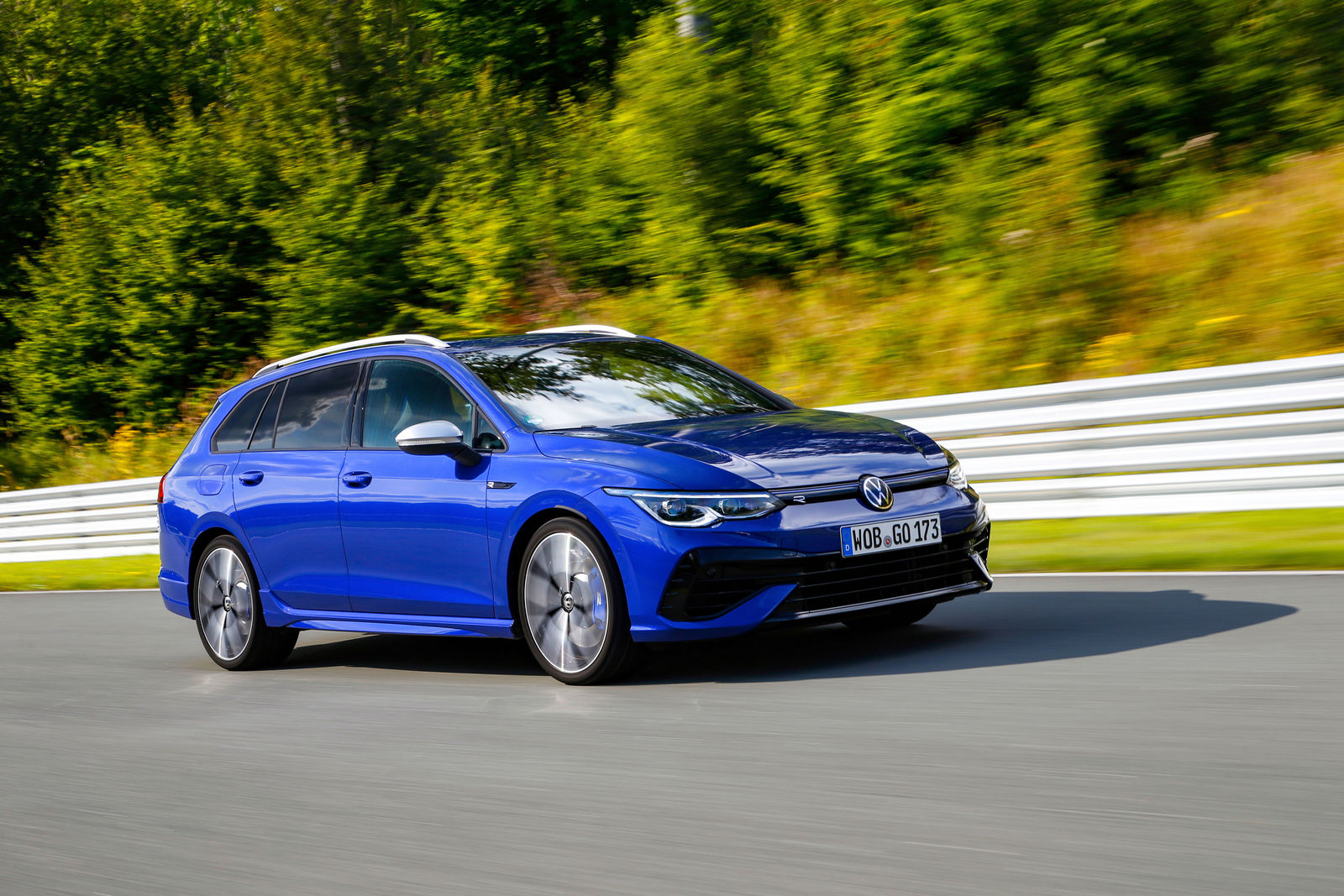The TSI engine. A true sports estate like the new Golf R Estate needs a powerful heartbeat, and for that, it has to be fitted with the best components. This applies without restriction to the legendary TSI from the EA888 product line in its fourth incarnation: As an evo4, the 1,984 cm3 four-cylinder turbocharged engine now develops an output of 235 kW (320 PS). That’s 14 kW (20 PS) more than the predecessor (third-generation) engine. The maximum torque has increased from 400 Nm to 420 Nm. This is available even at low engine speeds of just 2,100 rpm and remains constant at this high level up to speeds of 5,350 rpm. Integrated into the cylinder head of the direct-injection engine is a system for water-cooled exhaust gas recirculation to the turbocharger. And the TSI is economical too – a fully electronic coolant regulator unit enables very efficient thermal management with a short warm-up phase. Consumption in accordance with NEDC is just 7.3–7.2 l/100 km combined (CO2 emissions combined: 166–164 g/km). The TSI also features variable valve timing with double camshaft control. The new engine complies with the latest Euro 6d-ISC-FCM emission standard, in part thanks to the valve lift, which can be switched between two levels on the exhaust side. This allows optimum control of gas exchange with respect to performance, consumption and exhaust emissions. The 320-PS TSI’s impressive power is transmitted to all four wheels by a 7-speed DSG.
The 7-speed dual clutch gearbox (DSG). The new Golf R Estate is equipped as standard with the latest development stage of Volkswagen’s 7-speed DSG. The dual clutch gearbox is designed for high torque forces and offers excellent shifting performance without interrupting traction. This is thanks to the DSG’S sophisticated design. The dual clutch gearbox consists of two automated gear train halves, each with a clutch. One gear train half is for the even gears, the other for the odd gears. Both gear train halves work together on the same gearbox output. For example, if the vehicle is in fourth gear, the third or fifth gear is automatically pre-selected via the second gear train half. If the driver now accelerates or decelerates, one clutch closes at lightning speed while the other opens. This enables gear changes to be made within a few hundredths of a second, making it a key element of the sophisticated construction that is the high-performance Golf R Estate. Gear shifts are likewise fully electronic (shift-by-wire). On the one hand, this allows for a gear knob that is much smaller, thus saving space. On the other hand, it makes changing gear more comfortable for the driver. For example, thanks to shift-by-wire, the vehicle can already engage reverse while it is travelling forwards at low speeds, which facilitates manoeuvring. The Golf R Estate does not make its smooth shift to “R” until the speed is right. In this way, the electronics system prevents incorrect operation.
4MOTION all-wheel drive with R Performance torque vectoring. The new all-wheel drive system makes a central contribution to the impressive performance of the Golf R Estate. Thanks to a newly developed rear final drive, the drive power is distributed not only variably between the front and rear axles, but now also just as variably between the left and right rear wheels. This is how it works: The differential transfers the power via a multi-plate clutch to the left- and right-hand rear wheels with a ratio of 50:50 – even when the differential lets them rotate at different speeds while cornering. The way the 4MOTION all-wheel drive works is likewise familiar from other Volkswagen models manufactured on the basis of the modular transverse matrix (MQB). A new feature is that the torque is now also distributed variably across both rear wheels courtesy of the 4MOTION all-wheel drive with R Performance torque vectoring. In extreme cases, up to 100 percent of the potential power can be transmitted to the wheel on the outside of the bend. This clearly reduces the vehicle’s cornering radius, whilst at the same time reducing the danger that the Golf R Estate moves towards the outside of the bend if the driver turns into bends at speed (understeer). The intensity of the automatic power distribution is determined by the steering angle, accelerator pedal position, lateral acceleration, yaw rate (speed of rotation on the vertical axis) and speed at which the vehicle is being driven. The result is noticeably more agile driving behaviour. This agility is perfectly complemented by the new Golf R Estate’s progressive steering (which comes as standard) and the stabilising driving dynamics systems from the standard driving profile selection (Comfort, Sport, Race and Individual) to the profiles Special and Drift in the optional R Performance package, as well as the (optional) adaptive DCC sports running gear. In addition, the Vehicle Dynamics Manager, fitted in the Golf R Estate for the first time, ensures that the all-wheel drive system is closely integrated with the adaptive chassis control DCC, the electronic differential locks (XDS) and the progressive steering.
